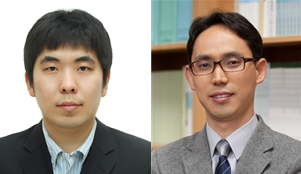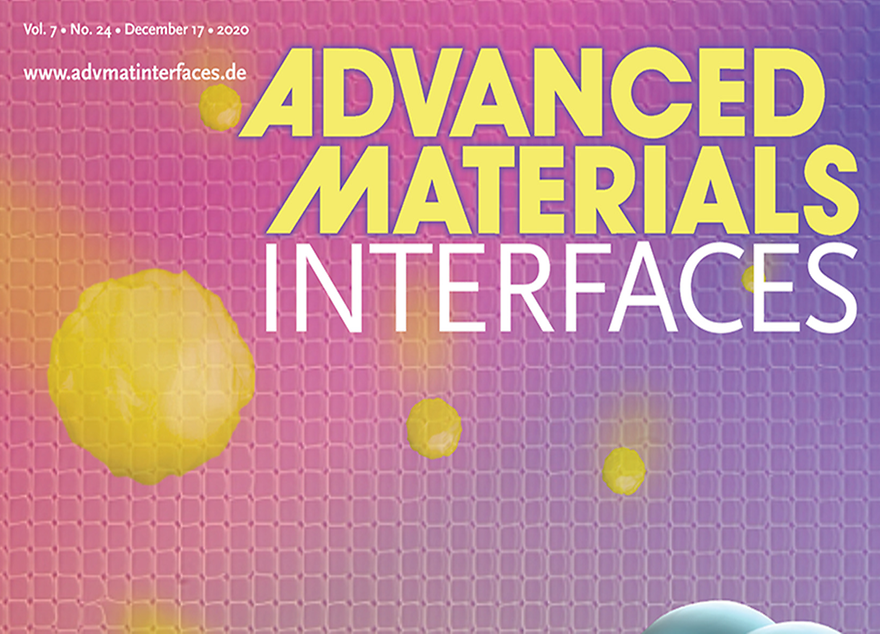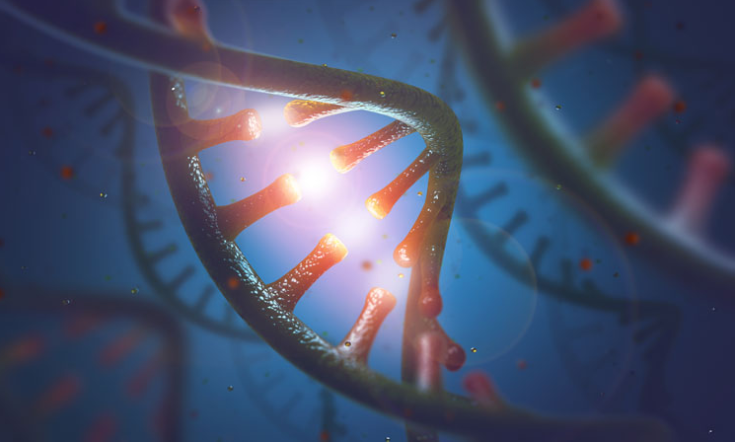-
A team of researchers from Ajou and Konkuk Universities has created a new polymer doping strategy based on their discovery of dynamic and thermodynamic factors affecting polymer doping.Prof. Kim Jong-hyun (Dept. of Applied Chemistry and Biological Engineering and Dept. of Molecular Science and Technology, pictured left) and Prof. Seo Hyung-tak (Dept. of Materials Science and Engineering, pictured right), both from Ajou, teamed up with Konkuk researchers led by Prof. Kim Bong-gi (Dept. of Organic and Nano System Engineering) to conduct the groundbreaking study, which has gone on to appear on the front cover of the December 10 issue of Advanced Materials (IF = 27.398). Professors Kim Jong-hyun, Seo Hyung-tak, and Kim Bong-gi participated as corresponding authors, and Yoon Sang-eun, currently in the combined postgraduate program in the Department of Molecular Science and Technology at Ajou University, was listed as the first author.The title of the study is “Improvement of Electrical Conductivity in Conjugated Polymers through Cascade Doping with Small-Molecular Dopants.”Active research on conjugated polymers for organic semiconductors has led to leaps in the performance of electric charge mobility, but researchers have struggled to achieve the desired high level of conductivity due to the difficulty of creating electric charges through doping that equally affects conductivity.The efficiency of molecular doping is known to be proportional to the energy offset between the highest occupied molecular orbital (HOMO) of the electron-supplying conjugated polymer and the lowest unoccupied molecular orbital (LUMO) of the electron-receiving dopant. In their latest study, the Ajou and Konkuk researchers demonstrated that sequential use of dopants with different LUMOs increases doping efficiency, and were able to achieve the world’s highest level of conductivity for molecular doping—above 600 S/cm—with their strategy.The team has also demonstrated that the low doping efficiency associated with the use of dopants with high energy offsets from conjugated polymers stems from thermodynamics. They discovered that doping efficiency can be dramatically increased when doping is first attempted using a molecular dopant with a low energy offset and superior doping dynamics, followed by the use of a second dopant with a high energy offset. The researchers confirmed that this cascade effect is attributed to the decrease in activation energy needed for molecular doping.Prof. Kim Jong-hyun explained: “Our study provides in-depth insights into the energy orbitals of various molecular dopants, the dynamic and thermodynamic equilibria, and the conductivity of finally doped polymers, as well as an effective polymer doping strategy. Using this kind of strategy can significantly improve the conductivity of organic conductors that has hit an impasse as of late.”The team expects that development of new materials alongside their cascade doping strategy can lead to the discovery of highly flexible and highly elastic organic conductors capable of replacing conventional metal and oxide-film inorganic conductors.<Courtesy of WILEY VCH>
-
25
- 작성자OI***
- 작성일2021-02-23
- 4821
- 동영상동영상
-
Prof. Cho In-sun (Dept. of Materials Science and Engineering, pictured) and his team have discovered a higher-efficiency photocathode capable of producing hydrogen energy from sunlight. The team’s discovery is expected to lead to a variety of economic applications in areas of energy technology where photovoltaic hydrogen generation is needed, such as solar cells and fuel cells.The team’s study on the new photocathode, at least four times more efficient than existing technology, was published in the November issue of Nano Energy (IF = 16.602) and entitled, “High-performance bulky crystalline copper bismuthate photocathode for enhanced solar water splitting.” Listed as authors were Dr. Shin Seong-sik of the Korea Research Institute of Chemical Technology; Seo Gab-kyung and Kim Bit-na, both first authors and currently enrolled in the master’s program at Ajou University; and Hwang Sung-won, a doctoral candidate at Ajou University.The depletion of fossil fuel resources and climate change have led to growing demand for sustainable energy, including solar water splitting technology that generates hydrogen for fuel from sunlight, all without carbon emissions. Researchers working in this field, however, have struggled until recently to improve the efficiency of that process to the extent required for commercialization. Interest has been growing in affordable photo-electrodes capable of absorbing sunlight with great efficiency to generate electric charges.Research on photo-electrode materials has so far been focused on photoanodes capable of generating oxygen from oxides. Interest in photocathodes capable of generating hydrogen directly from water splitting has been comparatively limited. Prof. Cho’s team, however, broke new ground by seizing on a crystalline copper bismuthate photocathode (CuBi₂O₄).Copper bismuthate is the optimal material for photocathodes as it is readily available on the surface of the earth and obtaining it exerts little environmental impact. It also boasts a conduction band conducive to water splitting, an extremely low band gap energy level (1.6 to 1.8 eV) and a high internal voltage (> 1V), raising the theoretically potential photocurrent level to as high as 29 mA/cm². In practice, however, it has been difficult to achieve that potential due to the inferior quality of the actual film that limits electric charge mobility.Prof. Cho’s team found a solution to this problem in the evaporation-decomposition-controlled (EDC) method for producing better-quality films. The EDC process, designed to produce affordable solutions, controls the speed at which the solvent evaporates in the pre-annealing process so as to regulate the density and speed of crystalline grain growth. This process helps produce a dense film consisting of large particles, which significantly improves the mobility of electric charges and doubles the amount of photocurrent obtained. Compared to conventional films produced by electrophoresis or spray-coating, the EDC method increases the film’s photocurrent efficiency fourfold.Prof. Cho’s team was able to demonstrate a high photocurrent density of 3.5 mA/cm2 under standard sunlight conditions by coupling the copper bismuthate photocathode with a copper oxide (CuO) nano-underlayer. The photocurrent density is the highest reported to date.Prof. Cho states: “We still need to further improve efficiency and stability and increase the film’s surface in order to make it viable on the market. We expect additional research will lead us to find ways to improve the productivity and economicity of solar water splitting.”He adds: “Our recent discovery can be expanded into a process for synthesizing various oxide semiconductor films, and may have useful applications in other areas of energy technology, including solar cells and fuel cells.”The study was undertaken with support from the Ministry of Science and ICT and the National Research Foundation of Korea’s support program for experienced researchers.Diagram of the double-bound (CuBi₂O₄ and CuO) photocathode made with the EDC process구리 비스무스 산화물CuBi₂O₄구리산화물CuO투명전극Transparent electrode유리 기판Glass substrateEffect of the CuBi2O4 film made with the EDC process(a)산소기체수소기체백금전극CBO전극(a)Oxygen gasHydrogen gasPlatinum electrodeCBO electrodeEDC 공정 -> Bulky CBO기존 공정 -> 기공 + 불순물EDC process à Bulky CBOConventional process à Porous + polluted(b)광전류(b)Photocurrent(d)이종접합 전극기존 전극 기술x 4배(d)Double-bound electrodeConventional electrodex4
-
23
- 작성자OI***
- 작성일2021-02-23
- 5104
- 동영상동영상
-
Scientists grow wrinkle patterns on polymer surfaces in a spontaneous and reversible manner, spurring advances in smart soft matter technologyNatural creases on animal skin have inspired the engineering of such patterns on polymers for the design of “smart surfaces.” However, the engineered patterns are often permanent, limiting their control. In their latest study, scientists from Ajou University, Korea, have come up with a way to form wrinkles on hydrogel surfaces in a controlled, reversible fashion, opening doors to innovations in soft-matter-based smart technology. Fabrication of polymer films with long-range wrinkle patterns can aid in the development of smart surfaces with applications in dry adhesion, sensing, and smart windows. A new study in Advanced Materials Interfaces reveals a way to control wrinkle formation in soft matter.Photo Courtesy: Advanced Materials Interfaces, Wiley Online Library Sometimes, simply looking at nature can inspire clever innovations in technology. In fact, an entire field of research, called “biomimetics,” is based on the idea of emulating nature to engineer novel structures like “smart surfaces,” which can change their shape or property in response to changes in the ambient environment (temperature, humidity, light intensity, pH, etc.)An inspiration for these smart surfaces comes from the crinkles or crease patterns found on the skin of animals. “The wrinkles on our skin are designed for practical purposes such as gripping objects without slipping or facilitating heat dissipation through a large surface area. In addition, they can be used to control alignment of small particles on a material surface without needing a complex chemical or physical interaction,” explains Dr. Tae Soup Shim from Ajou University, Korea, whose research group focuses on the design of smart surface materials. While such wrinkle patterns have been successfully engineered in polymeric materials, their precise control has been challenging due to the fact that such structures are often permanent. Now, in a new study published in Advanced Materials Interfaces, Dr. Shim and his colleagues found a way to format uniform wrinkle structures. In their design, they successfully formed crease patterns on a hydrogel (a crosslinking chain of “water-loving” polymers) film from its surface deformations, in a uniform manner. Dr. Shim says, “Through our study, we were able to control the wrinkle formation mechanism step by step, for the first time.”In their strategy, the scientists used a technique called “reaction-diffusion-mediated photopolymerization” (RDP) (essentially a UV-light-mediated polymerization reaction) to fabricate a hydrogel film called p(HEMA-co-AA) film, and then caused it to deform, giving rise to hill-and-valley-type structures. Depending on the properties of the UV light used, the structures could be either isotropic (with the same properties in all directions) or anisotropic (properties changing with direction). The scientists found that the anisotropic structures were the key to controlling the wrinkle formation process, and thus, they used a UV source with an anisotropic intensity profile to generate anisotropic hills and valleys. Then, the scientists increased the pH of the film, which caused it to swell and form the crease patterns. Since the swelling process is reversible, scientists could repeat the creasing and flattening of the film simply by changing the pH!Further, to demonstrate the aligning behavior of particles due to the crease patterns, scientists made the film interact with “free-moving” yeast cells. They noticed that as the creases developed, not only did the yeast cells align themselves along the crease patterns but also reproduced along them, showing guided cell growth. The p(HEMA-co-AA) film could, therefore, potentially serve as a suitable platform for studying other direction-specific cells and biomolecules, such as neurons and DNA. With such promising results, scientists are excited about the potential applications of wrinkle structures in real life. “We expect that the strategy implemented in our study will make the fabrication of polymer materials with a uniform wrinkle structure much easier. These polymers can then be used to design smart surface materials that can find applications in smart adhesion technology, gas sensing, and smart windows,” comments Prof. Shim. This study, indeed, adds a new wrinkle in the development of smart materials!ReferenceAuthors:Mina Kim1, Kwon-Young Choi2, Ju Min Kim1,3 and Tae Soup Shim1,3Title of original paper:Stepwise Evolution of Crease Patterns on Stimuli-Responsive Hydrogels for the Production of Long-Range Ordered StructuresJournal:Advanced Materials InterfacesDOI:10.1002/admi.202001551 Affiliations:1Department of Energy Systems Research, Ajou University 2Department of Environmental Engineering, Ajou University3Department of Chemical Engineering, Ajou University*Corresponding author’s email: tsshim@ajou.ac.kr About Ajou UniversityFounded in 1973, Ajou University has quickly grown to become one of the top universities in the Republic of Korea. With over 15,000 students and 50 research centers in diverse fields, Ajou University partakes in the largest national research and graduate education project funded by the Korean Ministry of Education. In line with its recently reformed vision, Ajou University’s goal is to change society by connecting minds and carrying out high-impact research to improve the welfare of people in and outside Korea. Website: https://www.ajou.ac.kr/en/index.do About the authorDr. Tae Soup Shim is an Associate Professor at the Departments of Chemical Engineering and Energy Systems Research, Ajou University, Korea. He received a PhD degree in Chemical and Biomolecular Engineering from KAIST, Korea. Following this, he worked as a postdoctoral researcher at Department of Chemical and Biomolecular Engineering, University of Pennsylvania, USA. His major research interests include colloidal self-assembly, stimuli-responsive materials, interfacial phenomena, and biomimetics. Currently, his group has been focusing on designing micro-/nanostructures based on soft matter for the development of shape-transformable soft actuators, flexible electronic devices, and smart surface materials.
-
21
- 작성자OI***
- 작성일2021-02-10
- 5335
- 동영상동영상
-
A breakthrough in 2D graphene fabrication paves the way for its large-scale production Graphene is a promising pure carbon 2D material that can revolutionize electronics. However, it is difficult to produce high-quality large-area graphene films. Now, scientists from Korea have developed a novel method to peel off uniform and atomically thin layers of graphene from a natural graphite crystal, paving the way for large-scale production. Graphene is a promising nanomaterial that could lead to tremendous advances in electronics, including bendable and wearable devices, faster transistors, and new semiconductors Photo courtesy: Shutterstock Graphene is a solid made purely from carbon atoms arranged in a 2D honeycomb-like structure. Its unique mechanical, chemical, electric, and optical properties have made it a hot topic in materials science; the next generation of electronics like faster transistors, wearable and bendable phones and other electronics can very well be based on graphene. Unfortunately, there are still no efficient ways to produce large-area graphene films with a thickness of a few atoms. If graphene is to revolutionize upcoming technology, a better fabrication technique is a must. That’s why a team of scientists from Korea, led by Associate Professor Jae-Hyun Lee from Ajou University, recently published a study in Science Advances in which they pioneer a promising strategy to produce atomically thin graphene films. Instead of going for a chemical route, they focused on developing a new method for the exfoliation—or peeling off—of graphene out of a natural graphite crystal. Traditional exfoliation methods involve removing thin layers of graphene from graphite using special adhesive tapes. However, this only yields pieces of graphene a few micrometers across. In the new strategy the scientists developed, a thin metallic film is first deposited on a large graphite crystal and then removed, lifting along a graphene film from the crystal. The key to this method is that the metallic film attracts carbon atoms in the top few layers with a slightly higher binding energy than carbon atoms in deeper layers. What’s more, different metals can yield large graphene layers with a uniform thickness of one, two, or three carbon atoms. “We studied the mechanisms by which cracks form when graphene is exfoliated and found a way to control them in size and direction at an atomic scale,” remarks Dr. Lee, “The area and density of the atomically thin graphene layers we extracted were respectively 4,200 and 6,000 times larger compared with existing exfoliation methods.” This study could solve the long-standing issue of producing high quality graphene films with high yield and large area, which has been an obstacle to the research and commercialization of graphene-based technology. Excited about the results, Dr. Lee concludes, “Graphene may bring forth a new generation of electronics, including faster transistors and even wearable and bendable phones. Our exfoliation technique paves the way for developing manufacturing process for the mass production of graphene and other 2D materials.” With any luck, refining this technique could set us on the course for a technological revolution! ReferenceAuthors:Ji-Yun Moon1, Minsoo Kim2, Seung-Il Kim1, Shuigang Xu2, Jun-Hui Choi3, Dongmok Whang4, Kenji Watanabe5, Takashi Taniguchi6, Dong Seop Park7, Juyeon Seo7, Sung Ho Cho7,*, Seok-Kyun Son3,* and Jae-Hyun Lee1,*Title of original paper:Layer-engineered large-area exfoliation of grapheneJournal:Science AdvancesDOI:10.1126/sciadv.abc6601Affiliations:1Department of Energy Systems Research and Department of Materials Science and Engineering, Ajou University2School of Physics and Astronomy, University of Manchester3Department of Physics, Mokpo National University4School of Advanced Materials Science and Engineering, Sungkyunkwan University5Research Center for Functional Materials, National Institute for Materials Science6International Center for Materials Nanoarchitectonics, National Institute for Materials Science7Mobile Display Process Architecture, Samsung Display*Corresponding authors’ emails: jaehyunlee@ajou.ac.kr (J.-H.L.)About Ajou UniversityFounded in 1973, Ajou University has quickly grown to become one of the top universities in the Republic of Korea. With over 15,000 students and 50 research centers in diverse fields, Ajou University partakes in the largest national research and graduate education project funded by the Korean Ministry of Education. In line with its recently reformed vision, Ajou University’s goal is to change society by connecting minds and carrying out high-impact research to improve the welfare of people in and outside Korea. Website: https://www.ajou.ac.kr/en/index.do About the authorDr. Jae-Hyun Lee is an Associate Professor at the Department of Energy Systems and Engineering at Ajou University, Korea. His group explores and develops new physics and phenomena using advanced two-dimensional (2D) materials. The particular speciality of his group is the mesoscopic investigation of new types of van der Waals (vdW) heterostructures, including carbon nanotubes, 2D materials, and nanowires.
-
19
- 작성자OI***
- 작성일2021-02-08
- 8728
- 동영상동영상
-
The NRF2 gene is known to be a cancer suppressor, but perhaps “it is two-faced,” scientists say, paving the way for better cancer research and treatment The NRF2 gene has been traditionally believed to suppress cancer with its antioxidant properties. However, recent cancer genome analyses suggest that NRF2 activation may, in fact, promote several cancers, including those of the lungs. In a new study, an international joint research team, including Korean scientists, finds evidence of this in mouse models of lung cancer and in data from two large clinical trials. Their findings can help understand cancer better, guiding us towards more effective therapies. Lung cancer is a leading cause of cancer deaths worldwide, but extensive research is yet to yield a sufficiently effective treatment option. However, now an international research group including scientists from Korea may just have stumbled upon a solution. Photo Courtesy: ShutterstockLung cancer is one of the most dreaded cancers today, given its massively high mortality rate. But while scientists have been trying to find a cure for decades, their efforts have met with little success. “I believe this is because we still don’t understand cancer correctly or fully,” says Prof. Sang-Min Jeon from Ajou University, Korea, who has been researching the roots of cancer. “I think that cancer originates in the microenvironment where toxins are accumulated such that cells that are able to utilize such toxins as nutrients proliferate and become cancerous.” Led by this belief, Prof. Jeon has recently turned to genes involved in the metabolism of toxins called reactive oxygen species (ROS)—free radicals or unstable atoms that can damage cells with their high reactivity. One such gene is NRF2, which, when activated, is believed to suppress cancer by reducing ROS. However, recent studies have detected aberrant activation of NRF2 in certain lung cancers, raising the possibility that it may be an “oncogene”—one that helps cause cancer—rather than a “cancer suppressor” gene. In their new study published in Clinical Cancer Research, Prof. Jeon and his international team of scientists confirm this possibility. In their study, Prof. Jeon and team took genetically modified mice with lung cancer and set out to check for NRF2 mutation. They found aberrant activation of NRF2 and saw that it assists other oncogenes in promoting the cancer, leading to decreased survival, despite reducing ROS toxicity. The team also analyzed the results of two large-scale human clinical trials, OAK and IMpower 131. Patients with an aberrantly active NRF2 showed poorer response to chemotherapy and immunotherapy and, therefore, had poorer prognosis and a significantly lower survival rate than those without NRF2 activation.Based on these findings, Prof. Jeon believes NRF2 inhibitors have great potential as therapeutic approaches for lung cancer. “As a next step, we have set up a biotech company called SCL Therapeutics where we are developing first-in-class NRF2 inhibitor drugs for cancer therapy. We are currently actively conducting preclinical trails”, he says. This study does provide remarkable insights into the driving mechanisms of lung cancer. Perhaps, Prof. Jeon’s hopes will translate to a revolutionary new therapy in the near future, and lung cancer will not be so dreadful after all. ReferenceAuthors:Anju Singh1, Anneleen Daemen2, Dorothee Nickles2, Sang-Min Jeon3,4, Oded Foreman5, Kuladeep Sudini1, Florian Gnad2, Stephane Lajoie1, Naina Gour1, Wayne Mitzner1, Samit Chatterjee1, Eun-Ji Choi4, Buvana Ravishankar6, Amy Rappaport7, Namrata Patil8, Mark McCleland8, Leisa Johnson7, George Acquaah-Mensah9, Edward Gabrielson10, Shyam Biswal1 and Georgia Hatzivassiliou3Title of original paper:NRF2 activation promotes aggressive lung cancer and associates with poor clinical outcomesJournal:Clinical Cancer Research DOI:10.1158/1078-0432.CCR-20-1985Affiliations:1Department of Environmental Health Science and Engineering, Johns Hopkins University School of Public Health 2Oncology Bioinformatics, Genentech Inc.3Translational Oncology, Genentech Inc.4College of Pharmacy and Research Institute of Pharmaceutical Science and Technology, Ajou University5Pathology, Genentech Inc.6Cancer Immunology, Genentech Inc.7Disocvery Oncology, Genentech Inc.8Oncology Biomarker Development, Genentech Inc.9Department of Pharmaceutical Sciences, Massachusetts College of Pharmacy and Health Sciences10Department of Pathology and Oncology, School of Medicine, Johns Hopkins University *Corresponding authors’ email: anneleen.daemen@gmail.com, nicklesd@gene.com, sbiswal@jhu.edu About Ajou UniversityFounded in 1973, Ajou University has quickly grown to become one of the top universities in the Republic of Korea. With over 15,000 students and 50 research centers in diverse fields, Ajou University partakes in the largest national research and graduate education project funded by the Korean Ministry of Education. In line with its recently reformed vision, Ajou University’s goal is to change society by connecting minds and carrying out high-impact research to improve the welfare of people in and outside Korea. Website: https://www.ajou.ac.kr/en/index.do About the authorSang-Min Jeon is an Associate Professor in the Department of Pharmacy at Ajou University. He is currently involved in cancer research to uncover the origin of cancer from a unique microenvironment-metabolism perspective. His goal is to develop innovative anti-cancer strategies based on the underlying causes of cancer. He is also engaged in the development new anti-cancer drugs through a biotech company that he has recently co-founded. Before coming to Ajou University, he completed his postdoctoral training at the Translational Oncology lab at Genentech Inc. in California, USA. In 2011, he received his PhD in Biochemistry and Molecular Genetics from the Chicago College of Medicine, University of Illinois, USA.
-
17
- 작성자OI***
- 작성일2021-02-05
- 5435
- 동영상동영상





